
Deposition Date
2004-11-29
Release Date
2005-02-15
Last Version Date
2023-08-23
Method Details:
Experimental Method:
Resolution:
1.95 Å
R-Value Free:
0.23
R-Value Work:
0.17
R-Value Observed:
0.17
Space Group:
C 1 2 1


